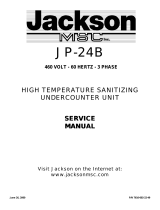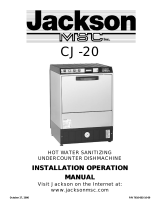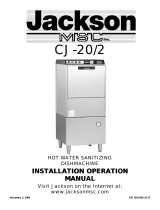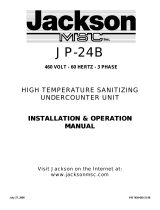Jackson MSC Inc. provides technical support for all of the dish-
machines detailed in this manual. We strongly recommend that
you refer to this manual before making a call to out technical sup-
port staff. Please have this manual with you when you call so that
our staff can refer you, if necessary, to the proper pager. Technical
support is available from 8:00 a.m. to 5:00 p.m. (EST), Monday
through Friday. Technical support is not available on holidays.
Contact technical support toll free at 1-888-800-5672. Please
remember that technical support is available to service personnel
only.
VISUAL INSPECTION: Before installing the unit, check the con-
tainer and machine for damage. A damaged container is an indi-
cator that there may be some damage to the machine. If there is
damage to both the container and machine, do not throw away the
container. The dishmachine has been inspected and packed at
the factory and is expected to arrive to you in new, undamaged
condition. However, rough handling by carriers or others may
result in there being damage to the unit while in transit. If such a
situation occurs, do not return the unit to Jackson; instead, contact
the carrier and ask them to send a representative to the site to
inspect the damage to the unit and to complete an inspection
report. You must contact the carrier within 48 hours of receiving
the machine. Also, contact the dealer through which you pur-
chased the unit.
UNPACKING THE DISHMACHINE: Once the machine has been
removed from the container, ensure that there are no missing
parts from the machine. This may not be obvious at first. If it is dis-
covered that an item is missing, contact Jackson immediately to
have the missing item shipped to you.
LEVEL THE DISHMACHINE: The dishmachine is designed to
operate while being level. This is important to prevent any dam-
age to the machine during operation and to ensure the best
results when washing ware. The unit comes with adjustable bullet
feet, which can be turned using a pair of channel locks or by hand
if the unit can be raised safely. Ensure that the unit is level from
side to side and from front to back before making any connec-
tions.
PLUMBING THE DISHMACHINE: All plumbing connections must
comply with all applicable local, state, and national plumbing
codes. The plumber is responsible for ensuring that the incoming
water line is throroughly flushed prior to connecting it to any com-
ponent of the dishmachine. It is necessary to remove all foreign
debris from the water line that may potentially get trapped in the
valves or cause an obstruction. Any valves that are fouled as a
result of foreign matter left in the water line, and any expenses
resulting from this fouling, are not the responsibility of the manu-
facturer.
STEAM CONNECTIONS: Connect all incoming steam lines in
accordance with the steam booster manufacturer’s instructions.
Your unit comes with lines on the machine for connection to an
outside steam source. Ensure that all applicable codes and regu-
lations are adhered to.
CONNECTING THE DRAIN LINE: The drains for the models cov-
ered in this manual are gravity disharge drains. All piping from the
1-1/2” FNPT connection on the waste accumulator must be
pitched (1/4” per foot) to the floor or sink drain. All piping from the
machine to the drain must be a minimum 1-1/2” I.P.S. and shall not
be reduced. There must also be an air gap between the machine
drain line and the floor sink or drain. If a grease trap is required by
code, it should have a flow capacity of 30 gallons per minute.
WATER SUPPLY CONNECTION: Ensure that you have read the
section entitled “PLUMBING THE DISHMACHINE” above before
proceding. Install the water supply line (3/4” pipe size minimum) to
the dishmachine line strainer using copper pipe. It is recommend-
ed that a water shut-off valve be installed in the water line between
the main supply and the machine to allow access for service. The
water supply line is to be capable of 25 PSI “flow” pressure at the
recommended temperature indicated on the data plate.
In areas where the water pressure fluctuates or is greater than the
recommended pressure, it is suggested that a water pressure reg-
ulator be installed. The models covered in this manual do come
with water pressure regulators as standard equipment. Please
notify Jackson immediately if this component is not present on
your machine.
Do not confuse static pressure with flow pressure. Static pressure
is the line pressure in a “no flow” condition (all valves and services
are closed). Flow pressure is the pressure in the fill line when the
fill valve is opened during the cycle.
It is also recommended that a shock absorber (not supplied) be
installed in the incoming water line. This prevents line hammer
(hydraulic shock), induced by the solenoid valve as it operates,
from causing damage to the equipment.
PLUMBING CHECK: Slowly turn on the water supply to the
machine after the incoming fill line and the drain line have been
installed. Check for any leaks and repair as required. All leaks
must be repaired prior to placing the machine in operation.
ELECTRICAL POWER CONNECTION: Electrical and grounding
connections must comply with the applicable portions of the
National Electrical Code ANSI/NFPA 70 (latest edition) and/or
other electrical codes.
Disconnect electrical power supply and place a tag at the discon-
nect switch to indicate that you are working on the circuit.
The dishmachine data plate is located on the right side and to the
front of the machine. Refer to the data plate for machine operat-
ing requirements, machine voltage, total amperage load and seri-
al number.
To install the incoming power lines, open the control box. Install
conduit into the pre-punched holes in the back of the control box.
Route power wires and connect to power block and grounding lug.
Install the service wires (L1, L2, and L3 (3 phase only)) to the
appropriate terminals as they are marked on the terminal block.
Install the grounding wire into the lug provided. Tighten the con-
nections. It is recommended that “DE-OX” or another similar anti-
oxidation agent be used on all power connections.
INSTALLATION INSTRUCTIONS
3




























